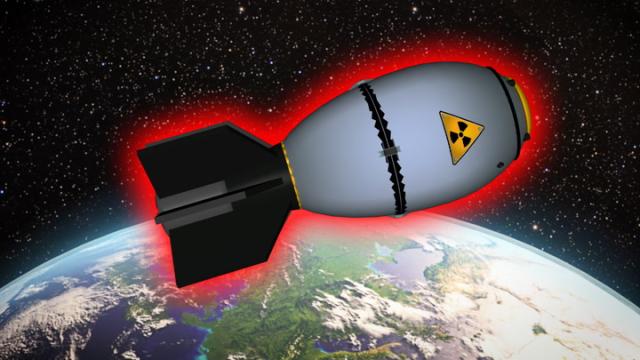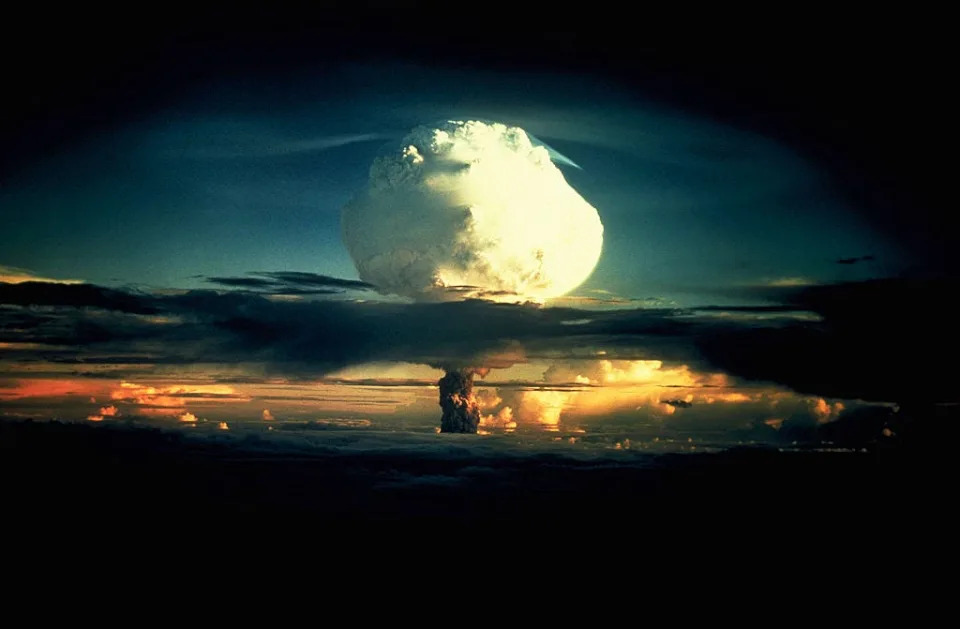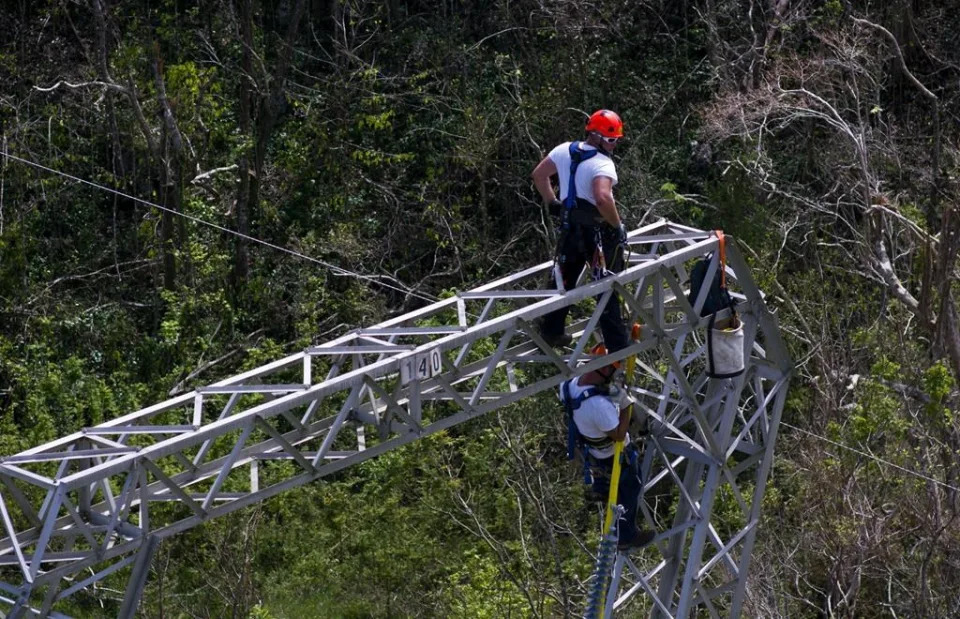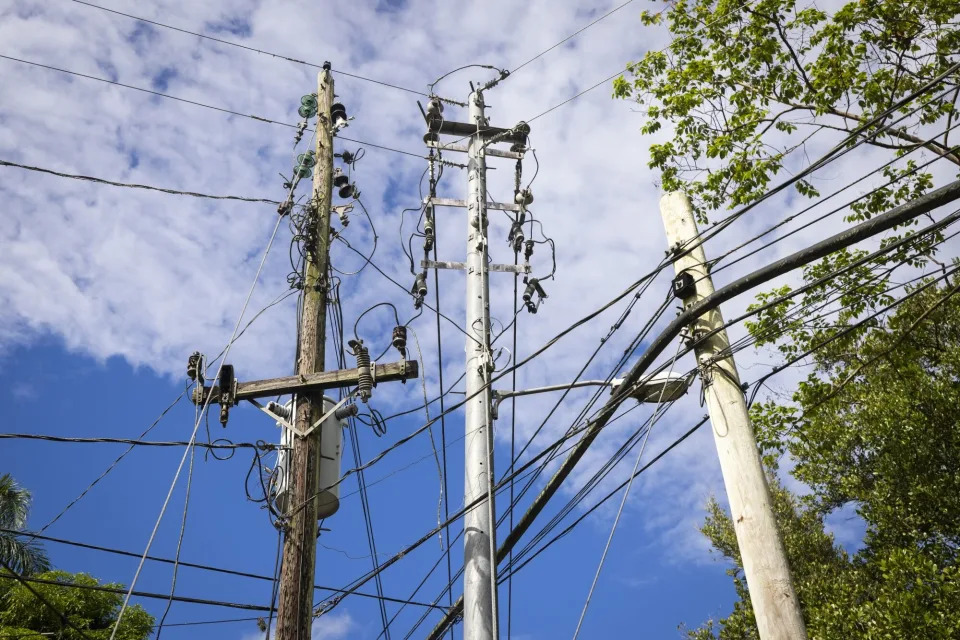How hydrogen bombs work and why they were created after WWII despite being more powerful than atomic bombs

Adam Barnes
Sun, August 27, 2023

The first hydrogen bomb test, as part of Operation Ivy, detonated over the Marshall Islands in 1952.Historical / Contributor / Getty Images
Seven years after the end of WWII, the US detonated the world's first hydrogen bomb.
H-bombs use a combination of nuclear fission and fusion and are far more powerful than atomic bombs.
Edward Teller, a physicist at Los Alamos, is often referred to as the "father of the hydrogen bomb."
The world's first nuclear weapon — the atom bomb — devastated the Japanese cities of Hiroshima and Nagasaki in 1945.
The force of the bombs was equivalent to 16 kilotons (16,000 tons) and 21 kilotons of TNT, respectively, and killed hundreds of thousands of people between the explosion and the effects of radioactive fallout.
But just seven years after dropping the atomic bombs, the United States detonated an even more powerful nuclear weapon: the hydrogen bomb.
A hydrogen bomb, also known as a thermonuclear bomb, can create explosive force hundreds or even thousands of times greater than an atomic bomb.
Here's how the H-bomb contains such massive power.
Hydrogen bombs harness the same type of energy that powers the sun
Atomic bombs rely on nuclear fission — the splitting of atoms — to create their power.
But the main force behind a hydrogen bomb's power is the opposite of fission — nuclear fusion, the fusing or binding of atoms.
Thermonuclear bombs use two isotopes of hydrogen — deuterium and tritium — for their fuel, hence the name "hydrogen bomb."

Nuclear fusion produces more energy than nuclear fission and is therefore why hydrogen bombs can generate more power than atomic weapons.colematt / Getty Images
In fusion, light elements undergo extreme temperature and pressure as they combine — or fuse — to form heavier elements and release very large amounts of energy in the process, Zaijing Sun, a nuclear physicist at the University of Nevada, Las Vegas, told Insider.
Given the same mass of fuel, fusion reactions release significantly more energy compared to fission, Sun said.
The fusion process is everywhere in the universe — it's what powers the sun. But achieving nuclear fusion on Earth is challenging due to the high temperature and pressure required, Sun said.
That extra challenge is why it took scientists longer to build a hydrogen bomb than the atomic bomb. Ultimately, to achieve fusion, scientists turned to fission for help.
The H-bomb's force comes from both fission and fusion
In order to start a fusion reaction, the hydrogen bomb consists of two stages: the primary stage and the secondary stage.
In the primary stage, uranium or plutonium are detonated with chemical explosives to create a fission reaction — just like an atomic bomb.
Powerful X-rays created by the fission reaction reflect off the bomb's uranium container, which directs them toward the secondary stage.

Notice that even the smallest atomic explosion in this graphic, Little Boy, still dwarfs the size of Mt. Everest.VISUAL CAPITALIST/SCIENCE PHOTO LIBRARY / Getty Images
The heat from this reaction reaches a temperature up to 100 million degrees Celsius — about four times hotter than the sun's core and hot enough to trigger fusion in the second stage.
The majority of the bomb's energy is released during this second stage, where the extreme heat and pressure from the fission explosion forces deuterium and tritium together, Sun said.
The enormous pressure also compresses the fusion fuel around a uranium or plutonium "spark plug," which starts to fission and further heats the fuel — making the fusion reaction more efficient.
And even after all that, there's still one more explosion left.
The colossal energy from the fusion reaction releases neutrons — subatomic particles that typically live inside atomic nuclei but in this case are ripped from their homes and set free.
The neutrons are free to slam into a layer of uranium casing that surrounds the fusion fuel — which triggers yet another fission reaction, adding more than half of the bomb's total explosive force.
This mix of fission and fusion reactions occurs nearly instantaneously, creating the massive destructive force of a hydrogen bomb.
In theory, a hydrogen bomb could use more than two stages — the explosion from the secondary stage could be used to ignite fusion in larger amounts of fuel in each subsequent stage.
In fact, the largest bomb ever created — the Tsar bomb — is believed to have been a three-stage fusion bomb.

This mockup of the Soviet AN-602 hydrogen bomb (Tsar Bomb) with a human walking by, for scale, shows how giant the bomb is in size.ALEXANDER NEMENOV / Staff / Getty Images
Detonated by the Soviet Union in 1961, the Tsar bomb created a 50 megaton explosion — nearly 1,500 times more powerful than the atomic bombs dropped on Hiroshima and Nagasaki combined, and more than 40 times as powerful as the largest nuclear weapon in the current US arsenal.
The bomb created a massive fireball about six miles in diameter and the mushroom cloud from it was 42 miles high and 60 miles wide.
Why create a hydrogen bomb?
As early as 1942, physicists, including J. Robert Oppenheimer, recognized that energy from fusion could create a massively powerful weapon.
But the development of the atomic fission bomb as part of the Manhattan Project took priority when Oppenheimer ran the Los Alamos lab during World War II.

Cillian Murphy as Oppenheimer in the film.Melinda Sue Gordon/Universal Pictures
Still, a group of physicists at Los Alamos kept working on the idea of a fusion bomb — and their work continued after the end of WWII.
In 1949, after the Soviet Union detonated its own fission bomb — much earlier than US physicists and governmental officials expected — discussions about accelerating the development of a hydrogen bomb began in earnest.
Some physicists, including Oppenheimer, who were concerned about the far greater destructive potential of hydrogen bombs compared to atomic bombs, opposed their development.
Enrico Fermi and Isidor Isaac Rabi, commenting on the vast power of hydrogen bombs, wrote in a report to the Atomic Energy Commission:
"Necessarily such a weapon goes far beyond any military objective and enters the range of very great natural catastrophes. By its very nature, it cannot be confined to a military objective but becomes a weapon which in practical effect is almost one of genocide."
Nonetheless, in 1950, amid rising tensions of the early Cold War, President Harry S. Truman approved using more resources to accelerate the development of the hydrogen bomb.
There were still technical challenges to harnessing fusion for a bomb. But a breakthrough came in 1951: Edward Teller, a physicist who worked on the Manhattan Project and an ardent supporter of developing the H-bomb, along with Stanislaw Ulam, created a workable design for the hydrogen bomb.

A playful moment captured of Edward Teller (left), the man who helped create the most destructive weapon on Earth, blowing bubbles in his lab. Historical / Contributor / Getty Images
The design introduced the concept of staging and using the energy of X-rays to ignite fusion. Their method is still used in modern thermonuclear weapons.
"The Teller-Ulam design is classic and might be the only efficient way to make an H-bomb," Sun said.
For his vocal support of the H-bomb and for his part in the weapon's design, Teller is often referred to as the "father of the hydrogen bomb."
Hydrogen bomb tests were incredibly powerful
On November 1, 1952, the US detonated the first hydrogen bomb at Enewetak atoll in the Marshall Islands.
Codenamed "Mike," the bomb produced the energy equivalent of about 10 megatons — or 10 million tons of TNT.
Hydrogen bomb tests continued, and in 1954, the US detonated its largest bomb — Castle Bravo — a 15 megaton blast over Bikini atoll. The explosion was over 1,000 times more powerful than the atomic bomb dropped over Hiroshima.
The blast was much larger than scientists expected and released large amounts of radiation into the atmosphere in what a nuclear weapons historian called "the greatest single radiological disaster in American history."

Nuclear fallout from Castle Bravo burned and discolored this Lucky Dragon crew member's face.NurPhoto / Contributor / Getty Images
Fallout ash rained down on some inhabited atolls, which had to be evacuated, as well as a Japanese tuna fishing boat, The Lucky Dragon, 86 miles away. All 23 crew members suffered from radiation sickness, and one died months later.
The Lucky Dragon had no radio so they didn't hear broadcasted warnings to stay away from the area around Bikini Atoll. Not knowing the ashy, white rain that fell upon them was nuclear fallout, the crew traveled back to Japan — all becoming very ill on the weeklong journey — and their irradiated fish entered the Japanese market.
The story of the Lucky Dragon was heavily covered by the international press, bringing the risk of nuclear fallout to the forefront of the public eye.
Nuclear weapons tests over the Marshall Islands continued until 1958. In all, the US conducted 67 nuclear tests near the islands.
The tests forced some local inhabitants to relocate, and the radioactive fallout created negative health effects — including elevated risk of cancer and birth defects — and contaminated the environment.
Due in part to the outcry over the threat of radioactive fallout, in 1963, the United States, Great Britain, and the Soviet Union signed the Limited Test Ban Treaty, banning nuclear tests in the atmosphere, underwater, or in outer space.
Hydrogen bombs today
As it stands, the world's nuclear weapons stockpile — many of them hydrogen bombs — numbers about 12,500 warheads, with the United States and Russia owning 89% of that total.
Considering the fearsome power of hydrogen bombs — the threat of nuclear war remains a terrifying reality.





















